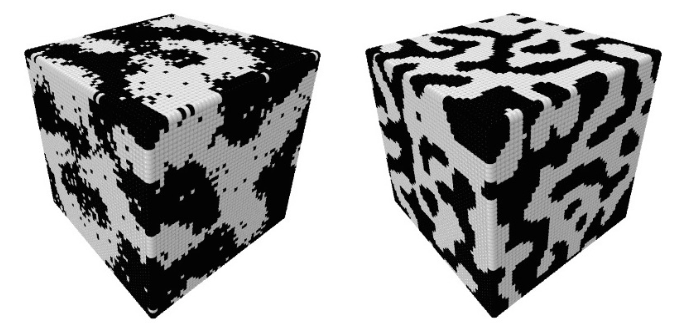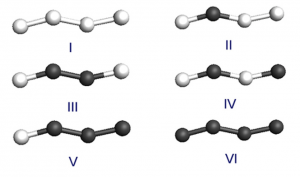Leonardo D. Machado Cristiano F. Woellner, Pedro A. S. Autreto
The Influence of Morphology on the Charge Transport in Two-Phase Disordered Organic Systems Journal Article
Em: Mater. Res. Soc. Symp. Proc., vol. 1737, 2015.
@article{Woellner2015,
title = {The Influence of Morphology on the Charge Transport in Two-Phase Disordered Organic Systems},
author = {Cristiano F. Woellner, Leonardo D. Machado, Pedro A. S. Autreto, Jose A. Freire, Douglas S. Galvao},
url = {http://journals.cambridge.org/action/displayAbstract?fromPage=online&aid=9707375&fulltextType=RA&fileId=S1946427415005023},
doi = {10.1557/opl.2015.502},
year = {2015},
date = {2015-05-22},
journal = {Mater. Res. Soc. Symp. Proc.},
volume = {1737},
abstract = {In this work we use a three-dimensional Pauli master equation to investigate the charge carrier mobility of a two-phase system, which can mimic donor-acceptor and amorphous- crystalline bulk heterojunctions. Our approach can be separated into two parts: the morphology generation and the charge transport modeling in the generated blend. The morphology part is based on a Monte Carlo simulation of binary mixtures (donor/acceptor). The second part is carried out by numerically solving the steady-state Pauli master equation. By taking the energetic disorder of each phase, their energy offset and domain morphology into consideration, we show that the carrier mobility can have a significant different behavior when compared to a one-phase system. When the energy offset is non-zero, we show that the mobility electric field dependence switches from negative to positive at a threshold field proportional to the energy offset. Additionally, the influence of morphology, through the domain size and the interfacial roughness parameters, on the transport was also investigated.},
keywords = {},
pubstate = {published},
tppubtype = {article}
}
da Silva Autreto, Pedro Alves; Galvao, Douglas S; Artacho, Emilio
Species fractionation in atomic chains from mechanically stretched alloys Journal Article
Em: Journal of Physics: Condensed Matter, vol. 26, não 43, pp. 435304, 2014.
@article{da2014species,
title = {Species fractionation in atomic chains from mechanically stretched alloys},
author = {da Silva Autreto, Pedro Alves and Galvao, Douglas S and Artacho, Emilio},
url = {http://iopscience.iop.org/0953-8984/26/43/435304},
year = {2014},
date = {2014-01-01},
journal = {Journal of Physics: Condensed Matter},
volume = {26},
number = {43},
pages = {435304},
publisher = {IOP Publishing},
abstract = {Bettini et al (2006 Nat. Nanotechnol. 1 182–5) reported the first experimental realization of linear atomic chains (LACs) composed of different atoms (Au and Ag). The different contents of Au and Ag were observed in the chains from what was found in the bulk alloys, which raises the question of what the wire composition is, if it is in equilibrium with a bulk alloy. In this work we address the thermodynamic driving force for species fractionation in LACs under tension, and we present the density-functional theory results for Ag–Au chain alloys. A pronounced stabilization of the wires with an alternating Ag–Au sequence is observed, which could be behind the experimentally observed Au enrichment in LACs from alloys with high Ag content.},
keywords = {},
pubstate = {published},
tppubtype = {article}
}
2015

Leonardo D. Machado Cristiano F. Woellner, Pedro A. S. Autreto
The Influence of Morphology on the Charge Transport in Two-Phase Disordered Organic Systems Journal Article
Em: Mater. Res. Soc. Symp. Proc., vol. 1737, 2015.
Resumo | Links | BibTeX | Tags: ab initio, conductance, nanowires
@article{Woellner2015,
title = {The Influence of Morphology on the Charge Transport in Two-Phase Disordered Organic Systems},
author = {Cristiano F. Woellner, Leonardo D. Machado, Pedro A. S. Autreto, Jose A. Freire, Douglas S. Galvao},
url = {http://journals.cambridge.org/action/displayAbstract?fromPage=online&aid=9707375&fulltextType=RA&fileId=S1946427415005023},
doi = {10.1557/opl.2015.502},
year = {2015},
date = {2015-05-22},
journal = {Mater. Res. Soc. Symp. Proc.},
volume = {1737},
abstract = {In this work we use a three-dimensional Pauli master equation to investigate the charge carrier mobility of a two-phase system, which can mimic donor-acceptor and amorphous- crystalline bulk heterojunctions. Our approach can be separated into two parts: the morphology generation and the charge transport modeling in the generated blend. The morphology part is based on a Monte Carlo simulation of binary mixtures (donor/acceptor). The second part is carried out by numerically solving the steady-state Pauli master equation. By taking the energetic disorder of each phase, their energy offset and domain morphology into consideration, we show that the carrier mobility can have a significant different behavior when compared to a one-phase system. When the energy offset is non-zero, we show that the mobility electric field dependence switches from negative to positive at a threshold field proportional to the energy offset. Additionally, the influence of morphology, through the domain size and the interfacial roughness parameters, on the transport was also investigated.},
keywords = {ab initio, conductance, nanowires},
pubstate = {published},
tppubtype = {article}
}
2014

da Silva Autreto, Pedro Alves; Galvao, Douglas S; Artacho, Emilio
Species fractionation in atomic chains from mechanically stretched alloys Journal Article
Em: Journal of Physics: Condensed Matter, vol. 26, não 43, pp. 435304, 2014.
Resumo | Links | BibTeX | Tags: ab initio, alloys, nanowires
@article{da2014species,
title = {Species fractionation in atomic chains from mechanically stretched alloys},
author = {da Silva Autreto, Pedro Alves and Galvao, Douglas S and Artacho, Emilio},
url = {http://iopscience.iop.org/0953-8984/26/43/435304},
year = {2014},
date = {2014-01-01},
journal = {Journal of Physics: Condensed Matter},
volume = {26},
number = {43},
pages = {435304},
publisher = {IOP Publishing},
abstract = {Bettini et al (2006 Nat. Nanotechnol. 1 182–5) reported the first experimental realization of linear atomic chains (LACs) composed of different atoms (Au and Ag). The different contents of Au and Ag were observed in the chains from what was found in the bulk alloys, which raises the question of what the wire composition is, if it is in equilibrium with a bulk alloy. In this work we address the thermodynamic driving force for species fractionation in LACs under tension, and we present the density-functional theory results for Ag–Au chain alloys. A pronounced stabilization of the wires with an alternating Ag–Au sequence is observed, which could be behind the experimentally observed Au enrichment in LACs from alloys with high Ag content.},
keywords = {ab initio, alloys, nanowires},
pubstate = {published},
tppubtype = {article}
}


